Building Information Modeling Report: Sydney Opera House
VerifiedAdded on 2022/08/13
|25
|4808
|23
Report
AI Summary
This report provides a comprehensive analysis of Building Information Modeling (BIM) applied to the Sydney Opera House. It explores the dimensions of BIM, including 3D, 4D, 5D, and 6D BIM, and discusses the levels of BIM development (LOD). The report examines the BIM execution plan, BIM tools and technologies, and the integration of BIM in New Zealand. A detailed project description of the Sydney Opera House is provided, including its design concept and the benefits of BIM implementation. The report also includes a critical evaluation of BIM, suggestions for improvement, and recommendations. The report is based on the case study report on Sydney Opera House. The report also covers the BIM execution plan, BIM tools and technologies, and suggestions on how to improve BIM. The report also provides a detailed look at the Sydney Opera House, including its original design and current use.
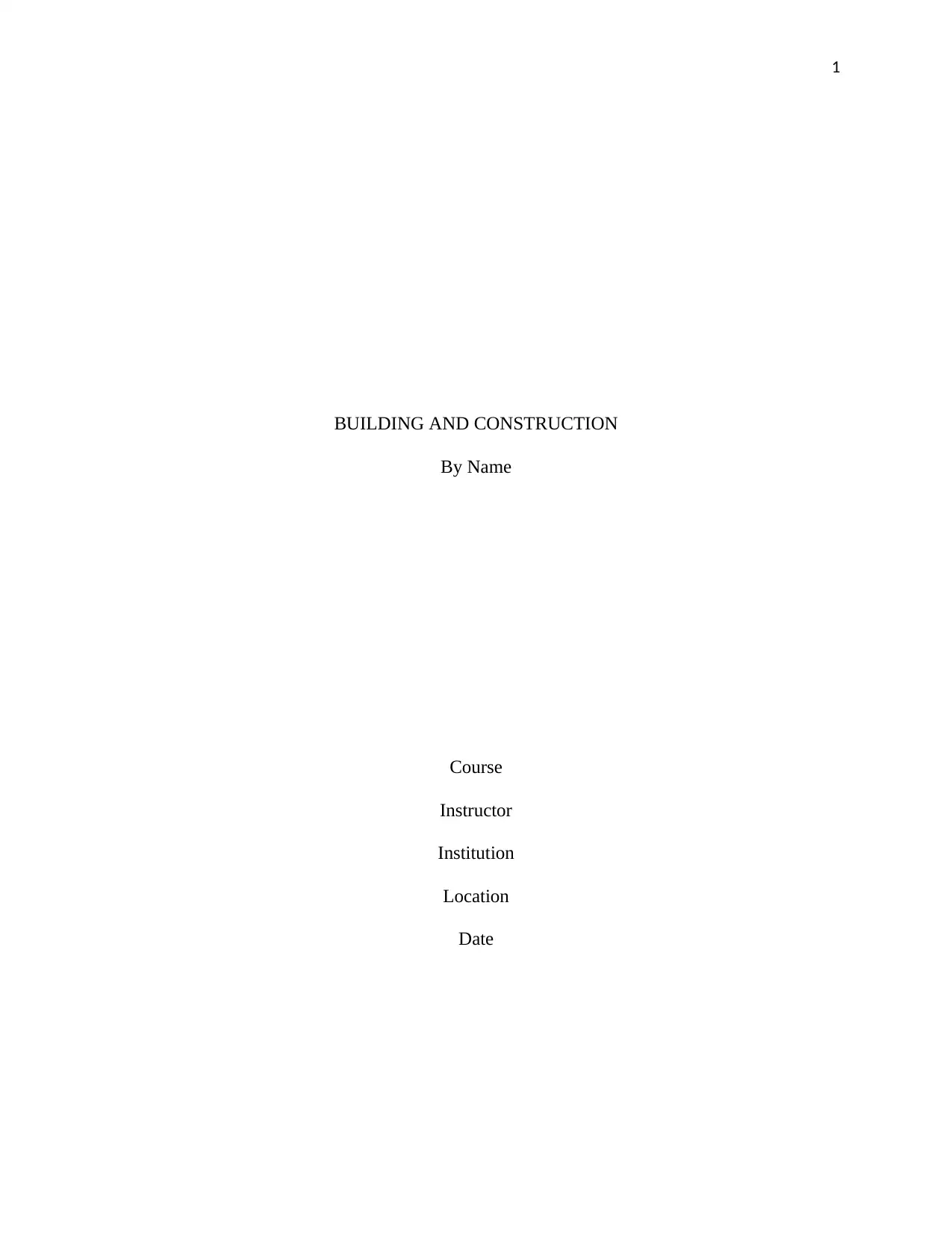
1
BUILDING AND CONSTRUCTION
By Name
Course
Instructor
Institution
Location
Date
BUILDING AND CONSTRUCTION
By Name
Course
Instructor
Institution
Location
Date
Paraphrase This Document
Need a fresh take? Get an instant paraphrase of this document with our AI Paraphraser
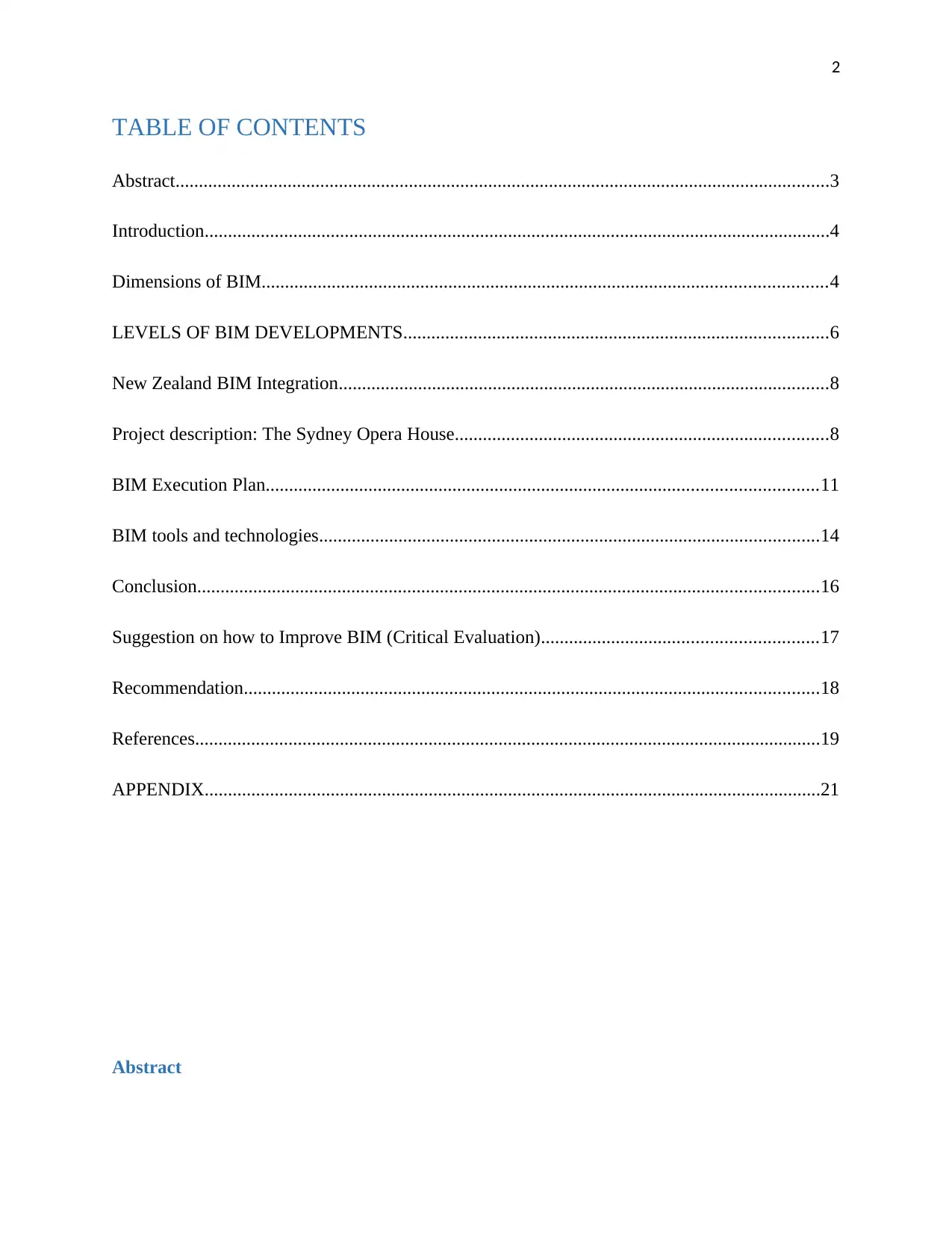
2
TABLE OF CONTENTS
Abstract............................................................................................................................................3
Introduction......................................................................................................................................4
Dimensions of BIM.........................................................................................................................4
LEVELS OF BIM DEVELOPMENTS...........................................................................................6
New Zealand BIM Integration.........................................................................................................8
Project description: The Sydney Opera House................................................................................8
BIM Execution Plan......................................................................................................................11
BIM tools and technologies...........................................................................................................14
Conclusion.....................................................................................................................................16
Suggestion on how to Improve BIM (Critical Evaluation)...........................................................17
Recommendation...........................................................................................................................18
References......................................................................................................................................19
APPENDIX....................................................................................................................................21
Abstract
TABLE OF CONTENTS
Abstract............................................................................................................................................3
Introduction......................................................................................................................................4
Dimensions of BIM.........................................................................................................................4
LEVELS OF BIM DEVELOPMENTS...........................................................................................6
New Zealand BIM Integration.........................................................................................................8
Project description: The Sydney Opera House................................................................................8
BIM Execution Plan......................................................................................................................11
BIM tools and technologies...........................................................................................................14
Conclusion.....................................................................................................................................16
Suggestion on how to Improve BIM (Critical Evaluation)...........................................................17
Recommendation...........................................................................................................................18
References......................................................................................................................................19
APPENDIX....................................................................................................................................21
Abstract
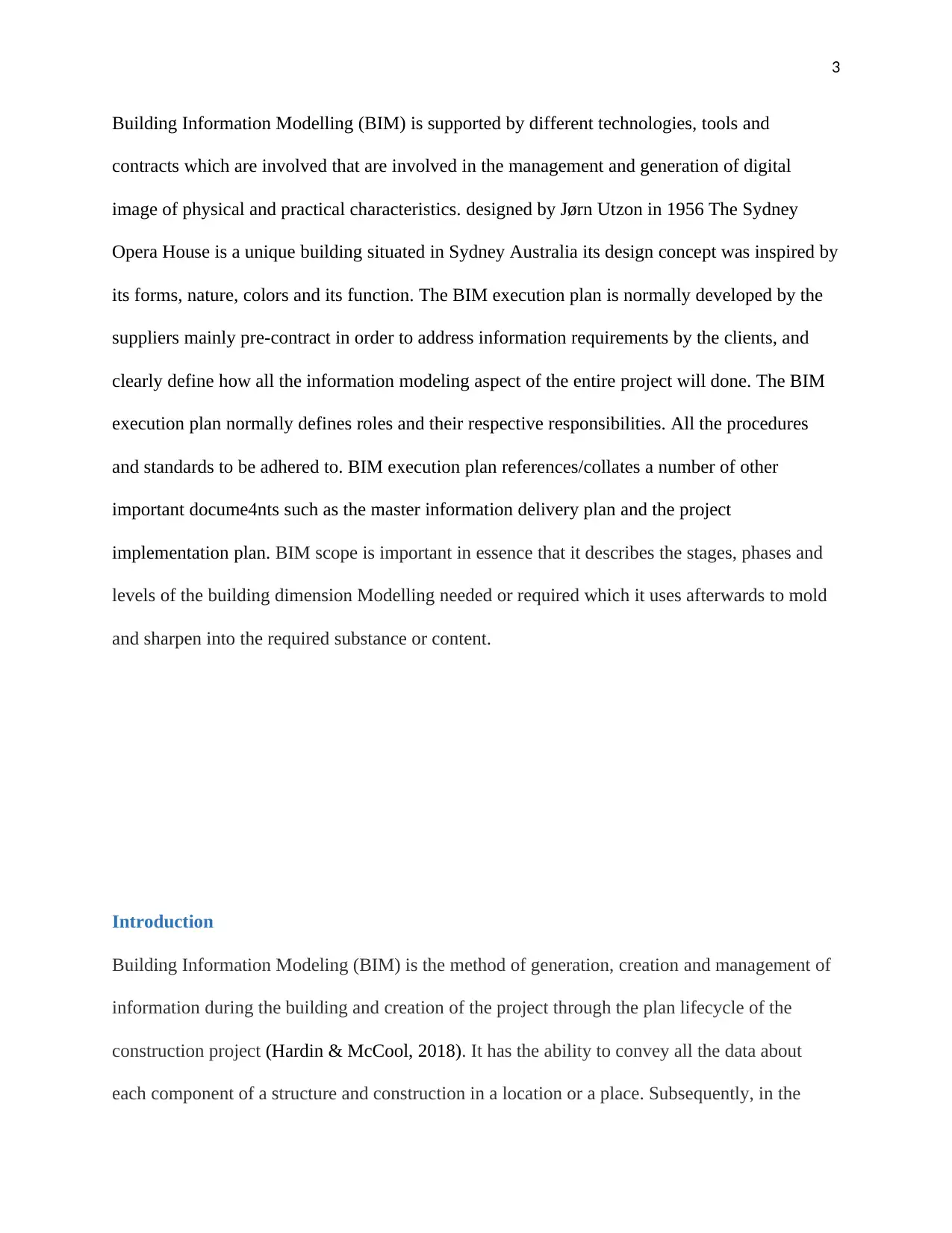
3
Building Information Modelling (BIM) is supported by different technologies, tools and
contracts which are involved that are involved in the management and generation of digital
image of physical and practical characteristics. designed by Jørn Utzon in 1956 The Sydney
Opera House is a unique building situated in Sydney Australia its design concept was inspired by
its forms, nature, colors and its function. The BIM execution plan is normally developed by the
suppliers mainly pre-contract in order to address information requirements by the clients, and
clearly define how all the information modeling aspect of the entire project will done. The BIM
execution plan normally defines roles and their respective responsibilities. All the procedures
and standards to be adhered to. BIM execution plan references/collates a number of other
important docume4nts such as the master information delivery plan and the project
implementation plan. BIM scope is important in essence that it describes the stages, phases and
levels of the building dimension Modelling needed or required which it uses afterwards to mold
and sharpen into the required substance or content.
Introduction
Building Information Modeling (BIM) is the method of generation, creation and management of
information during the building and creation of the project through the plan lifecycle of the
construction project (Hardin & McCool, 2018). It has the ability to convey all the data about
each component of a structure and construction in a location or a place. Subsequently, in the
Building Information Modelling (BIM) is supported by different technologies, tools and
contracts which are involved that are involved in the management and generation of digital
image of physical and practical characteristics. designed by Jørn Utzon in 1956 The Sydney
Opera House is a unique building situated in Sydney Australia its design concept was inspired by
its forms, nature, colors and its function. The BIM execution plan is normally developed by the
suppliers mainly pre-contract in order to address information requirements by the clients, and
clearly define how all the information modeling aspect of the entire project will done. The BIM
execution plan normally defines roles and their respective responsibilities. All the procedures
and standards to be adhered to. BIM execution plan references/collates a number of other
important docume4nts such as the master information delivery plan and the project
implementation plan. BIM scope is important in essence that it describes the stages, phases and
levels of the building dimension Modelling needed or required which it uses afterwards to mold
and sharpen into the required substance or content.
Introduction
Building Information Modeling (BIM) is the method of generation, creation and management of
information during the building and creation of the project through the plan lifecycle of the
construction project (Hardin & McCool, 2018). It has the ability to convey all the data about
each component of a structure and construction in a location or a place. Subsequently, in the
⊘ This is a preview!⊘
Do you want full access?
Subscribe today to unlock all pages.

Trusted by 1+ million students worldwide
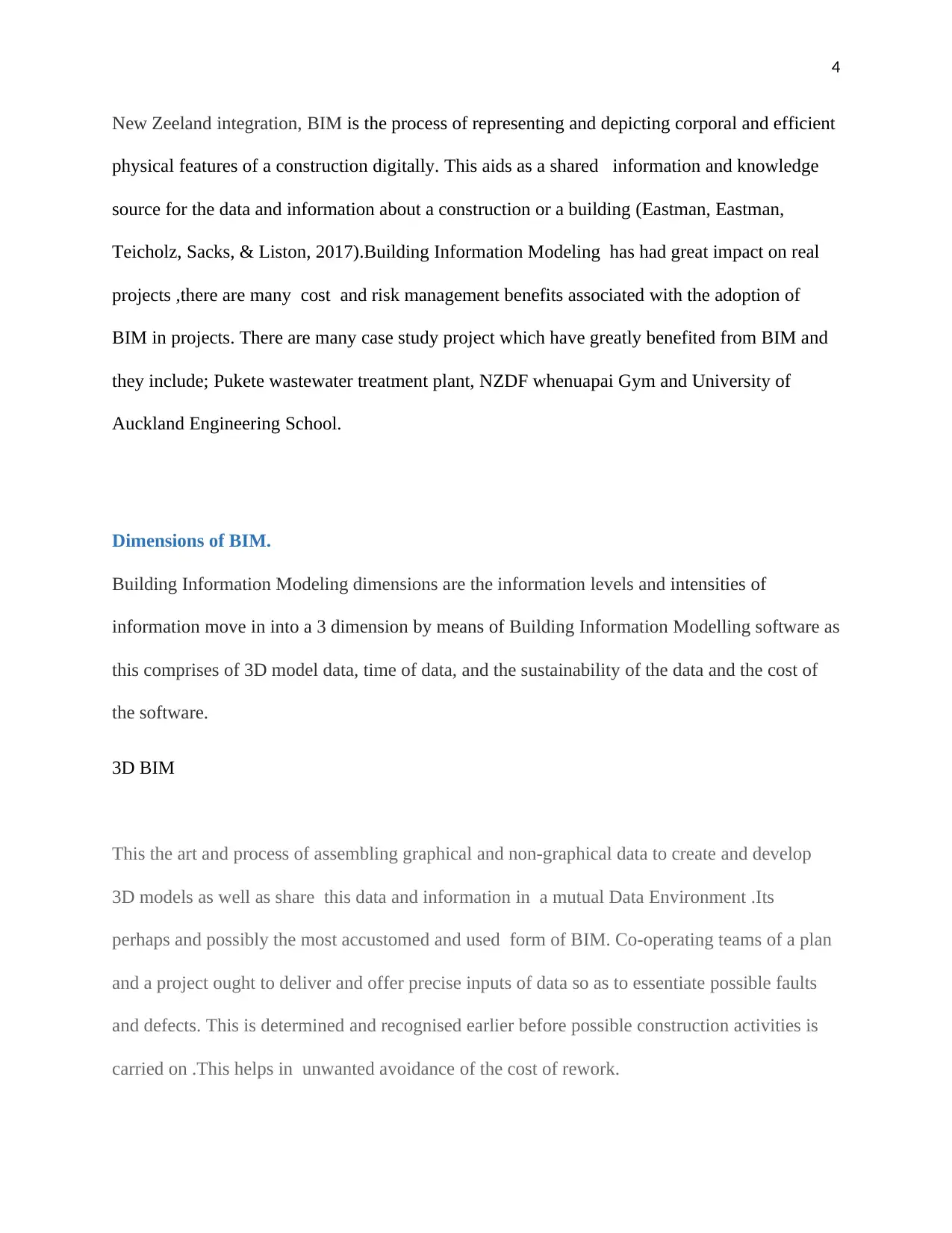
4
New Zeeland integration, BIM is the process of representing and depicting corporal and efficient
physical features of a construction digitally. This aids as a shared information and knowledge
source for the data and information about a construction or a building (Eastman, Eastman,
Teicholz, Sacks, & Liston, 2017).Building Information Modeling has had great impact on real
projects ,there are many cost and risk management benefits associated with the adoption of
BIM in projects. There are many case study project which have greatly benefited from BIM and
they include; Pukete wastewater treatment plant, NZDF whenuapai Gym and University of
Auckland Engineering School.
Dimensions of BIM.
Building Information Modeling dimensions are the information levels and intensities of
information move in into a 3 dimension by means of Building Information Modelling software as
this comprises of 3D model data, time of data, and the sustainability of the data and the cost of
the software.
3D BIM
This the art and process of assembling graphical and non-graphical data to create and develop
3D models as well as share this data and information in a mutual Data Environment .Its
perhaps and possibly the most accustomed and used form of BIM. Co-operating teams of a plan
and a project ought to deliver and offer precise inputs of data so as to essentiate possible faults
and defects. This is determined and recognised earlier before possible construction activities is
carried on .This helps in unwanted avoidance of the cost of rework.
New Zeeland integration, BIM is the process of representing and depicting corporal and efficient
physical features of a construction digitally. This aids as a shared information and knowledge
source for the data and information about a construction or a building (Eastman, Eastman,
Teicholz, Sacks, & Liston, 2017).Building Information Modeling has had great impact on real
projects ,there are many cost and risk management benefits associated with the adoption of
BIM in projects. There are many case study project which have greatly benefited from BIM and
they include; Pukete wastewater treatment plant, NZDF whenuapai Gym and University of
Auckland Engineering School.
Dimensions of BIM.
Building Information Modeling dimensions are the information levels and intensities of
information move in into a 3 dimension by means of Building Information Modelling software as
this comprises of 3D model data, time of data, and the sustainability of the data and the cost of
the software.
3D BIM
This the art and process of assembling graphical and non-graphical data to create and develop
3D models as well as share this data and information in a mutual Data Environment .Its
perhaps and possibly the most accustomed and used form of BIM. Co-operating teams of a plan
and a project ought to deliver and offer precise inputs of data so as to essentiate possible faults
and defects. This is determined and recognised earlier before possible construction activities is
carried on .This helps in unwanted avoidance of the cost of rework.
Paraphrase This Document
Need a fresh take? Get an instant paraphrase of this document with our AI Paraphraser
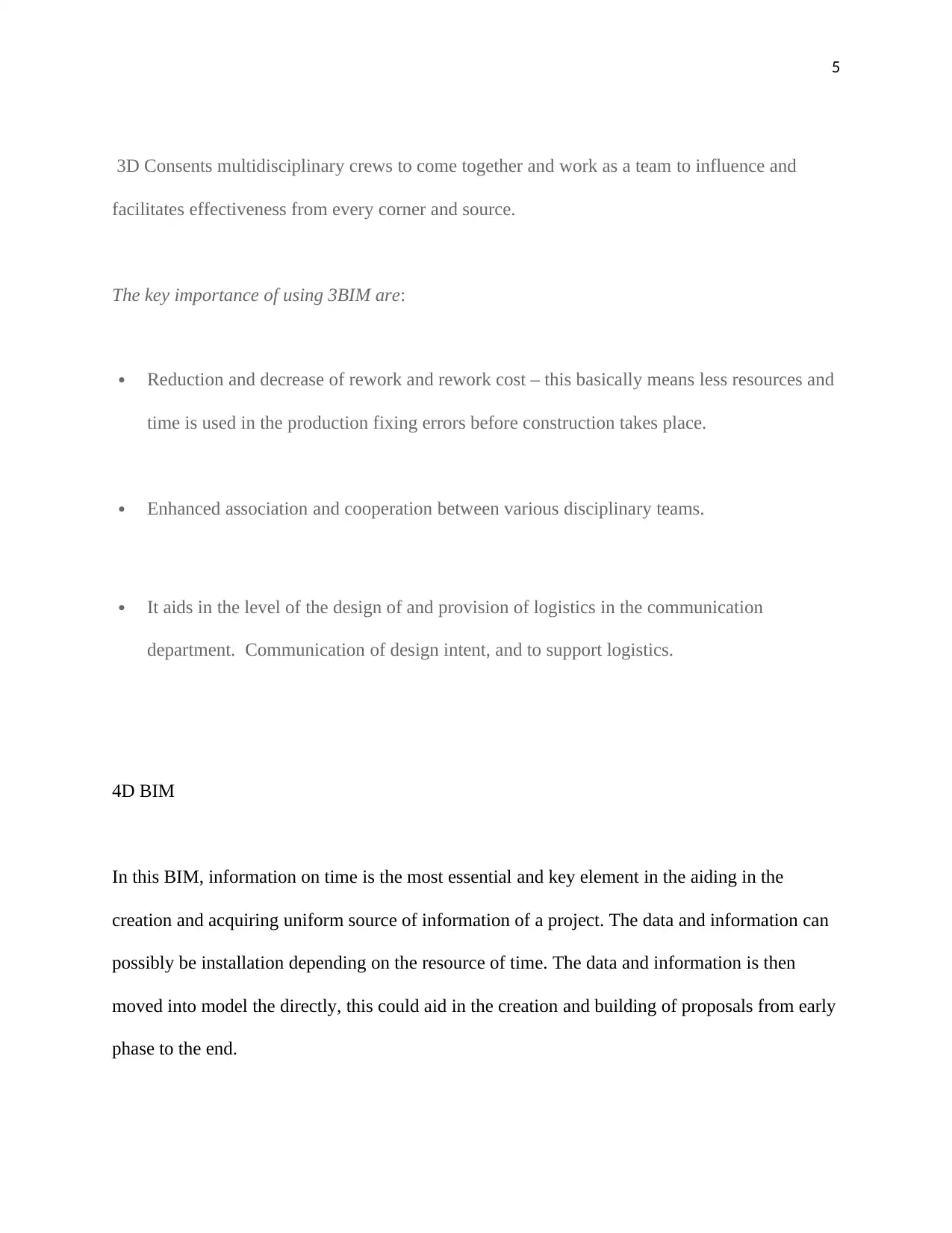
5
3D Consents multidisciplinary crews to come together and work as a team to influence and
facilitates effectiveness from every corner and source.
The key importance of using 3BIM are:
Reduction and decrease of rework and rework cost – this basically means less resources and
time is used in the production fixing errors before construction takes place.
Enhanced association and cooperation between various disciplinary teams.
It aids in the level of the design of and provision of logistics in the communication
department. Communication of design intent, and to support logistics.
4D BIM
In this BIM, information on time is the most essential and key element in the aiding in the
creation and acquiring uniform source of information of a project. The data and information can
possibly be installation depending on the resource of time. The data and information is then
moved into model the directly, this could aid in the creation and building of proposals from early
phase to the end.
3D Consents multidisciplinary crews to come together and work as a team to influence and
facilitates effectiveness from every corner and source.
The key importance of using 3BIM are:
Reduction and decrease of rework and rework cost – this basically means less resources and
time is used in the production fixing errors before construction takes place.
Enhanced association and cooperation between various disciplinary teams.
It aids in the level of the design of and provision of logistics in the communication
department. Communication of design intent, and to support logistics.
4D BIM
In this BIM, information on time is the most essential and key element in the aiding in the
creation and acquiring uniform source of information of a project. The data and information can
possibly be installation depending on the resource of time. The data and information is then
moved into model the directly, this could aid in the creation and building of proposals from early
phase to the end.
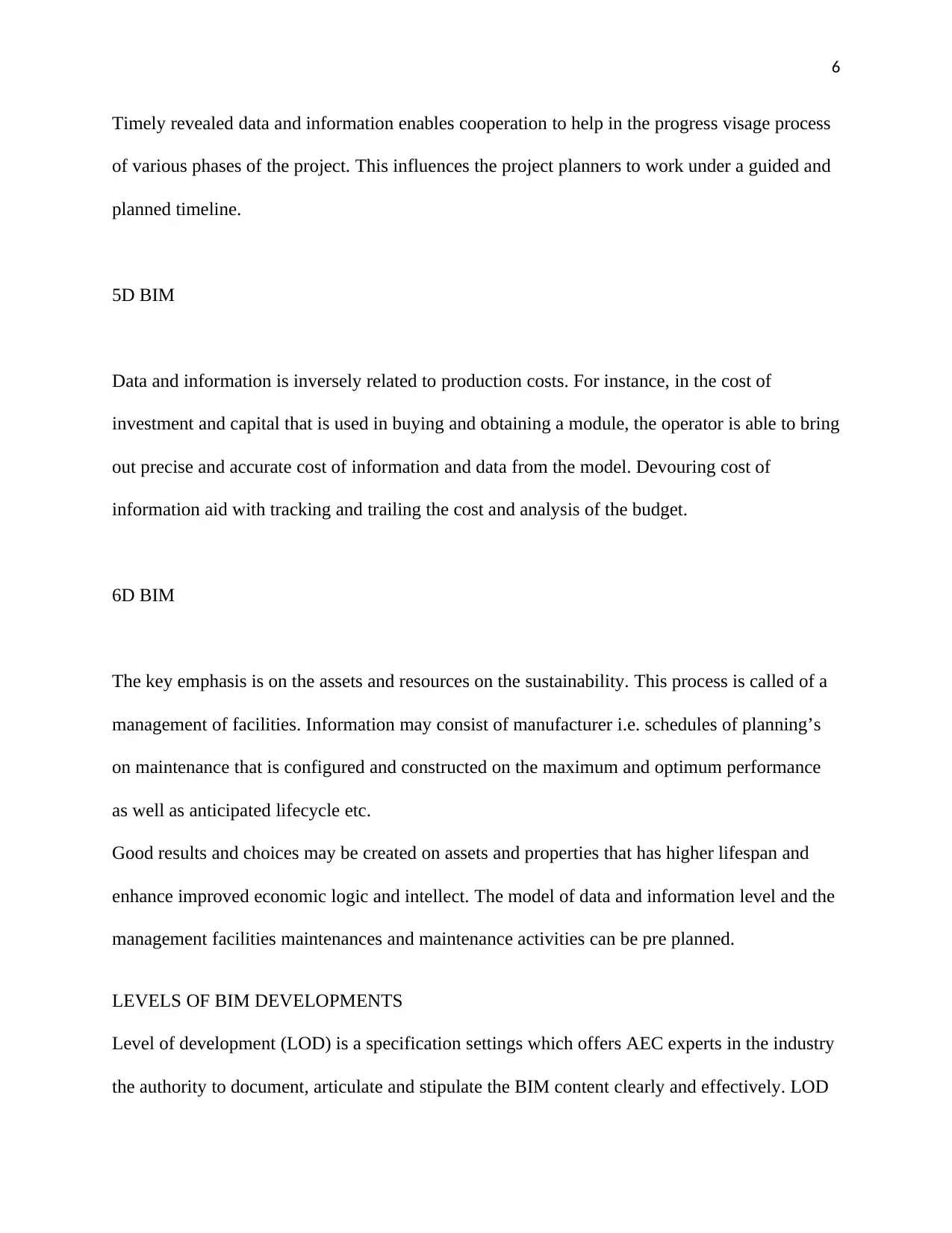
6
Timely revealed data and information enables cooperation to help in the progress visage process
of various phases of the project. This influences the project planners to work under a guided and
planned timeline.
5D BIM
Data and information is inversely related to production costs. For instance, in the cost of
investment and capital that is used in buying and obtaining a module, the operator is able to bring
out precise and accurate cost of information and data from the model. Devouring cost of
information aid with tracking and trailing the cost and analysis of the budget.
6D BIM
The key emphasis is on the assets and resources on the sustainability. This process is called of a
management of facilities. Information may consist of manufacturer i.e. schedules of planning’s
on maintenance that is configured and constructed on the maximum and optimum performance
as well as anticipated lifecycle etc.
Good results and choices may be created on assets and properties that has higher lifespan and
enhance improved economic logic and intellect. The model of data and information level and the
management facilities maintenances and maintenance activities can be pre planned.
LEVELS OF BIM DEVELOPMENTS
Level of development (LOD) is a specification settings which offers AEC experts in the industry
the authority to document, articulate and stipulate the BIM content clearly and effectively. LOD
Timely revealed data and information enables cooperation to help in the progress visage process
of various phases of the project. This influences the project planners to work under a guided and
planned timeline.
5D BIM
Data and information is inversely related to production costs. For instance, in the cost of
investment and capital that is used in buying and obtaining a module, the operator is able to bring
out precise and accurate cost of information and data from the model. Devouring cost of
information aid with tracking and trailing the cost and analysis of the budget.
6D BIM
The key emphasis is on the assets and resources on the sustainability. This process is called of a
management of facilities. Information may consist of manufacturer i.e. schedules of planning’s
on maintenance that is configured and constructed on the maximum and optimum performance
as well as anticipated lifecycle etc.
Good results and choices may be created on assets and properties that has higher lifespan and
enhance improved economic logic and intellect. The model of data and information level and the
management facilities maintenances and maintenance activities can be pre planned.
LEVELS OF BIM DEVELOPMENTS
Level of development (LOD) is a specification settings which offers AEC experts in the industry
the authority to document, articulate and stipulate the BIM content clearly and effectively. LOD
⊘ This is a preview!⊘
Do you want full access?
Subscribe today to unlock all pages.

Trusted by 1+ million students worldwide
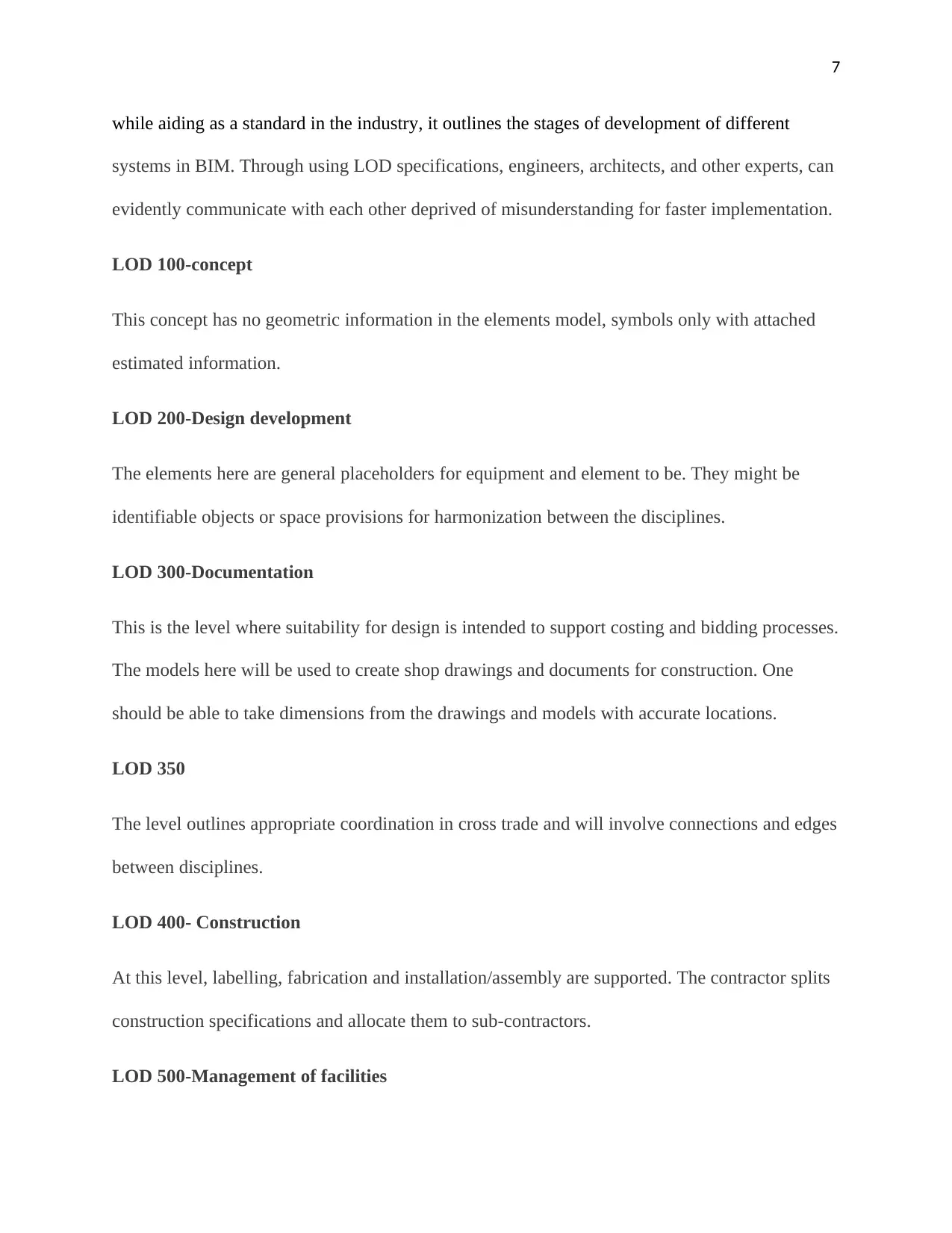
7
while aiding as a standard in the industry, it outlines the stages of development of different
systems in BIM. Through using LOD specifications, engineers, architects, and other experts, can
evidently communicate with each other deprived of misunderstanding for faster implementation.
LOD 100-concept
This concept has no geometric information in the elements model, symbols only with attached
estimated information.
LOD 200-Design development
The elements here are general placeholders for equipment and element to be. They might be
identifiable objects or space provisions for harmonization between the disciplines.
LOD 300-Documentation
This is the level where suitability for design is intended to support costing and bidding processes.
The models here will be used to create shop drawings and documents for construction. One
should be able to take dimensions from the drawings and models with accurate locations.
LOD 350
The level outlines appropriate coordination in cross trade and will involve connections and edges
between disciplines.
LOD 400- Construction
At this level, labelling, fabrication and installation/assembly are supported. The contractor splits
construction specifications and allocate them to sub-contractors.
LOD 500-Management of facilities
while aiding as a standard in the industry, it outlines the stages of development of different
systems in BIM. Through using LOD specifications, engineers, architects, and other experts, can
evidently communicate with each other deprived of misunderstanding for faster implementation.
LOD 100-concept
This concept has no geometric information in the elements model, symbols only with attached
estimated information.
LOD 200-Design development
The elements here are general placeholders for equipment and element to be. They might be
identifiable objects or space provisions for harmonization between the disciplines.
LOD 300-Documentation
This is the level where suitability for design is intended to support costing and bidding processes.
The models here will be used to create shop drawings and documents for construction. One
should be able to take dimensions from the drawings and models with accurate locations.
LOD 350
The level outlines appropriate coordination in cross trade and will involve connections and edges
between disciplines.
LOD 400- Construction
At this level, labelling, fabrication and installation/assembly are supported. The contractor splits
construction specifications and allocate them to sub-contractors.
LOD 500-Management of facilities
Paraphrase This Document
Need a fresh take? Get an instant paraphrase of this document with our AI Paraphraser
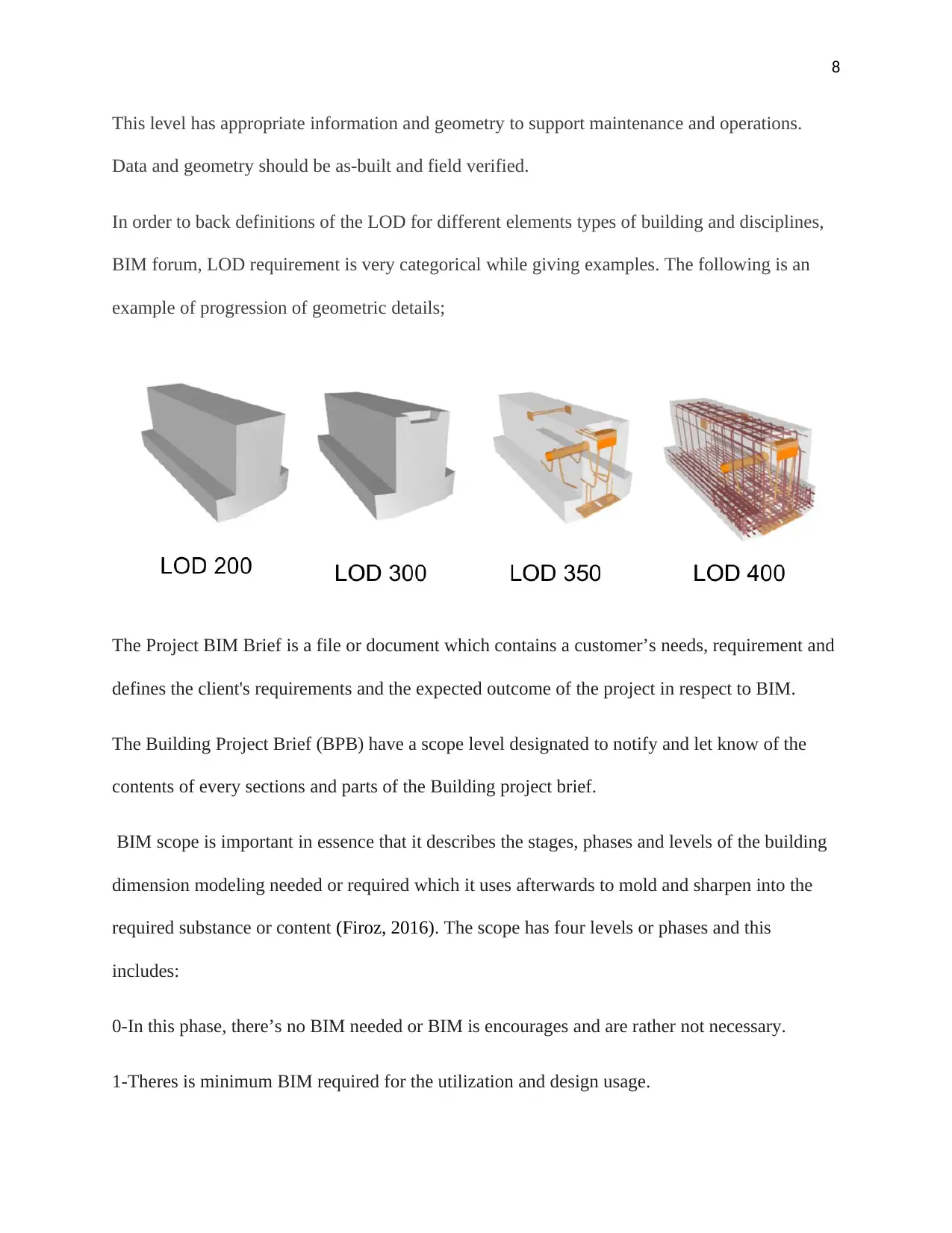
8
This level has appropriate information and geometry to support maintenance and operations.
Data and geometry should be as-built and field verified.
In order to back definitions of the LOD for different elements types of building and disciplines,
BIM forum, LOD requirement is very categorical while giving examples. The following is an
example of progression of geometric details;
The Project BIM Brief is a file or document which contains a customer’s needs, requirement and
defines the client's requirements and the expected outcome of the project in respect to BIM.
The Building Project Brief (BPB) have a scope level designated to notify and let know of the
contents of every sections and parts of the Building project brief.
BIM scope is important in essence that it describes the stages, phases and levels of the building
dimension modeling needed or required which it uses afterwards to mold and sharpen into the
required substance or content (Firoz, 2016). The scope has four levels or phases and this
includes:
0-In this phase, there’s no BIM needed or BIM is encourages and are rather not necessary.
1-Theres is minimum BIM required for the utilization and design usage.
This level has appropriate information and geometry to support maintenance and operations.
Data and geometry should be as-built and field verified.
In order to back definitions of the LOD for different elements types of building and disciplines,
BIM forum, LOD requirement is very categorical while giving examples. The following is an
example of progression of geometric details;
The Project BIM Brief is a file or document which contains a customer’s needs, requirement and
defines the client's requirements and the expected outcome of the project in respect to BIM.
The Building Project Brief (BPB) have a scope level designated to notify and let know of the
contents of every sections and parts of the Building project brief.
BIM scope is important in essence that it describes the stages, phases and levels of the building
dimension modeling needed or required which it uses afterwards to mold and sharpen into the
required substance or content (Firoz, 2016). The scope has four levels or phases and this
includes:
0-In this phase, there’s no BIM needed or BIM is encourages and are rather not necessary.
1-Theres is minimum BIM required for the utilization and design usage.
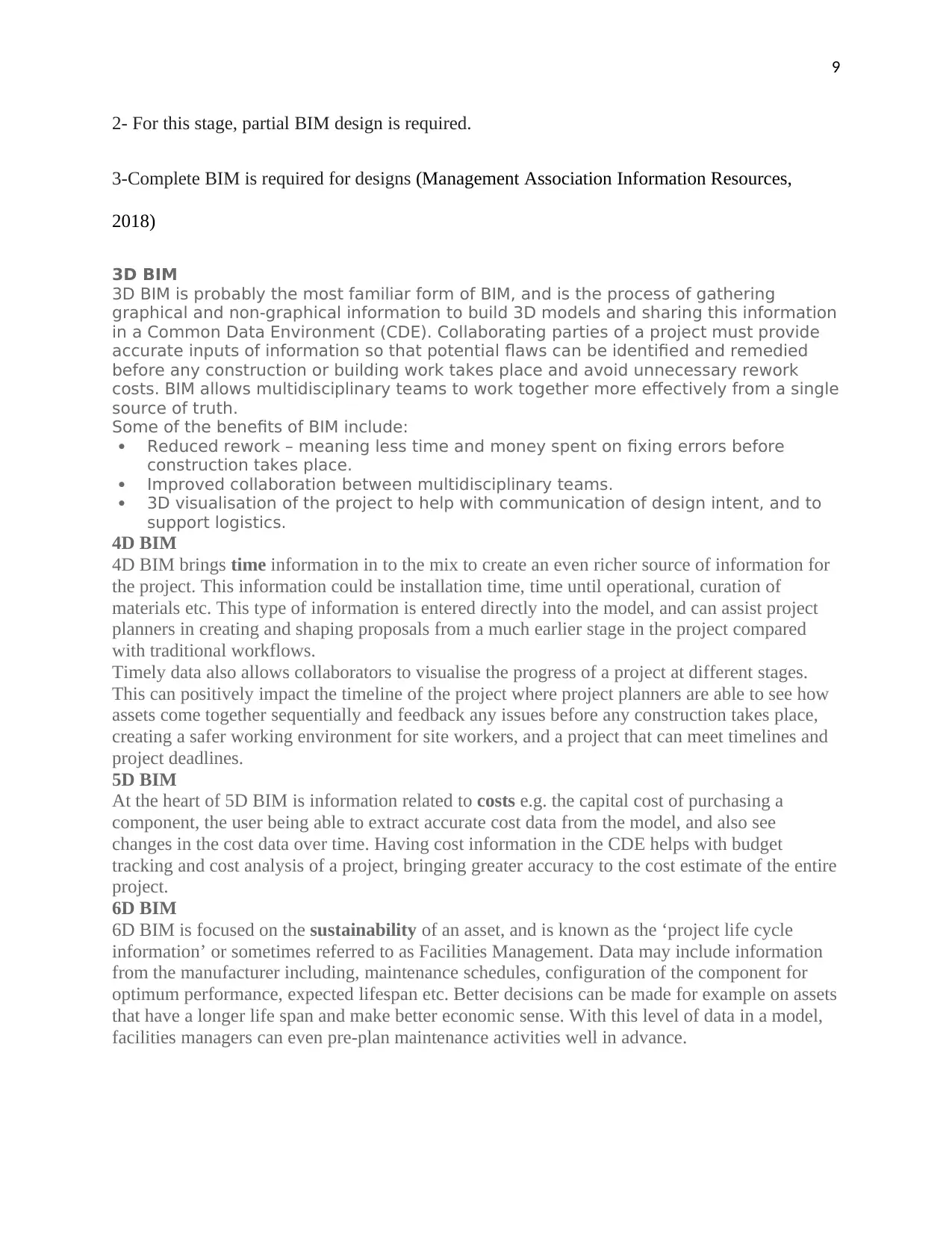
9
2- For this stage, partial BIM design is required.
3-Complete BIM is required for designs (Management Association Information Resources,
2018)
3D BIM
3D BIM is probably the most familiar form of BIM, and is the process of gathering
graphical and non-graphical information to build 3D models and sharing this information
in a Common Data Environment (CDE). Collaborating parties of a project must provide
accurate inputs of information so that potential flaws can be identified and remedied
before any construction or building work takes place and avoid unnecessary rework
costs. BIM allows multidisciplinary teams to work together more effectively from a single
source of truth.
Some of the benefits of BIM include:
Reduced rework – meaning less time and money spent on fixing errors before
construction takes place.
Improved collaboration between multidisciplinary teams.
3D visualisation of the project to help with communication of design intent, and to
support logistics.
4D BIM
4D BIM brings time information in to the mix to create an even richer source of information for
the project. This information could be installation time, time until operational, curation of
materials etc. This type of information is entered directly into the model, and can assist project
planners in creating and shaping proposals from a much earlier stage in the project compared
with traditional workflows.
Timely data also allows collaborators to visualise the progress of a project at different stages.
This can positively impact the timeline of the project where project planners are able to see how
assets come together sequentially and feedback any issues before any construction takes place,
creating a safer working environment for site workers, and a project that can meet timelines and
project deadlines.
5D BIM
At the heart of 5D BIM is information related to costs e.g. the capital cost of purchasing a
component, the user being able to extract accurate cost data from the model, and also see
changes in the cost data over time. Having cost information in the CDE helps with budget
tracking and cost analysis of a project, bringing greater accuracy to the cost estimate of the entire
project.
6D BIM
6D BIM is focused on the sustainability of an asset, and is known as the ‘project life cycle
information’ or sometimes referred to as Facilities Management. Data may include information
from the manufacturer including, maintenance schedules, configuration of the component for
optimum performance, expected lifespan etc. Better decisions can be made for example on assets
that have a longer life span and make better economic sense. With this level of data in a model,
facilities managers can even pre-plan maintenance activities well in advance.
2- For this stage, partial BIM design is required.
3-Complete BIM is required for designs (Management Association Information Resources,
2018)
3D BIM
3D BIM is probably the most familiar form of BIM, and is the process of gathering
graphical and non-graphical information to build 3D models and sharing this information
in a Common Data Environment (CDE). Collaborating parties of a project must provide
accurate inputs of information so that potential flaws can be identified and remedied
before any construction or building work takes place and avoid unnecessary rework
costs. BIM allows multidisciplinary teams to work together more effectively from a single
source of truth.
Some of the benefits of BIM include:
Reduced rework – meaning less time and money spent on fixing errors before
construction takes place.
Improved collaboration between multidisciplinary teams.
3D visualisation of the project to help with communication of design intent, and to
support logistics.
4D BIM
4D BIM brings time information in to the mix to create an even richer source of information for
the project. This information could be installation time, time until operational, curation of
materials etc. This type of information is entered directly into the model, and can assist project
planners in creating and shaping proposals from a much earlier stage in the project compared
with traditional workflows.
Timely data also allows collaborators to visualise the progress of a project at different stages.
This can positively impact the timeline of the project where project planners are able to see how
assets come together sequentially and feedback any issues before any construction takes place,
creating a safer working environment for site workers, and a project that can meet timelines and
project deadlines.
5D BIM
At the heart of 5D BIM is information related to costs e.g. the capital cost of purchasing a
component, the user being able to extract accurate cost data from the model, and also see
changes in the cost data over time. Having cost information in the CDE helps with budget
tracking and cost analysis of a project, bringing greater accuracy to the cost estimate of the entire
project.
6D BIM
6D BIM is focused on the sustainability of an asset, and is known as the ‘project life cycle
information’ or sometimes referred to as Facilities Management. Data may include information
from the manufacturer including, maintenance schedules, configuration of the component for
optimum performance, expected lifespan etc. Better decisions can be made for example on assets
that have a longer life span and make better economic sense. With this level of data in a model,
facilities managers can even pre-plan maintenance activities well in advance.
⊘ This is a preview!⊘
Do you want full access?
Subscribe today to unlock all pages.

Trusted by 1+ million students worldwide
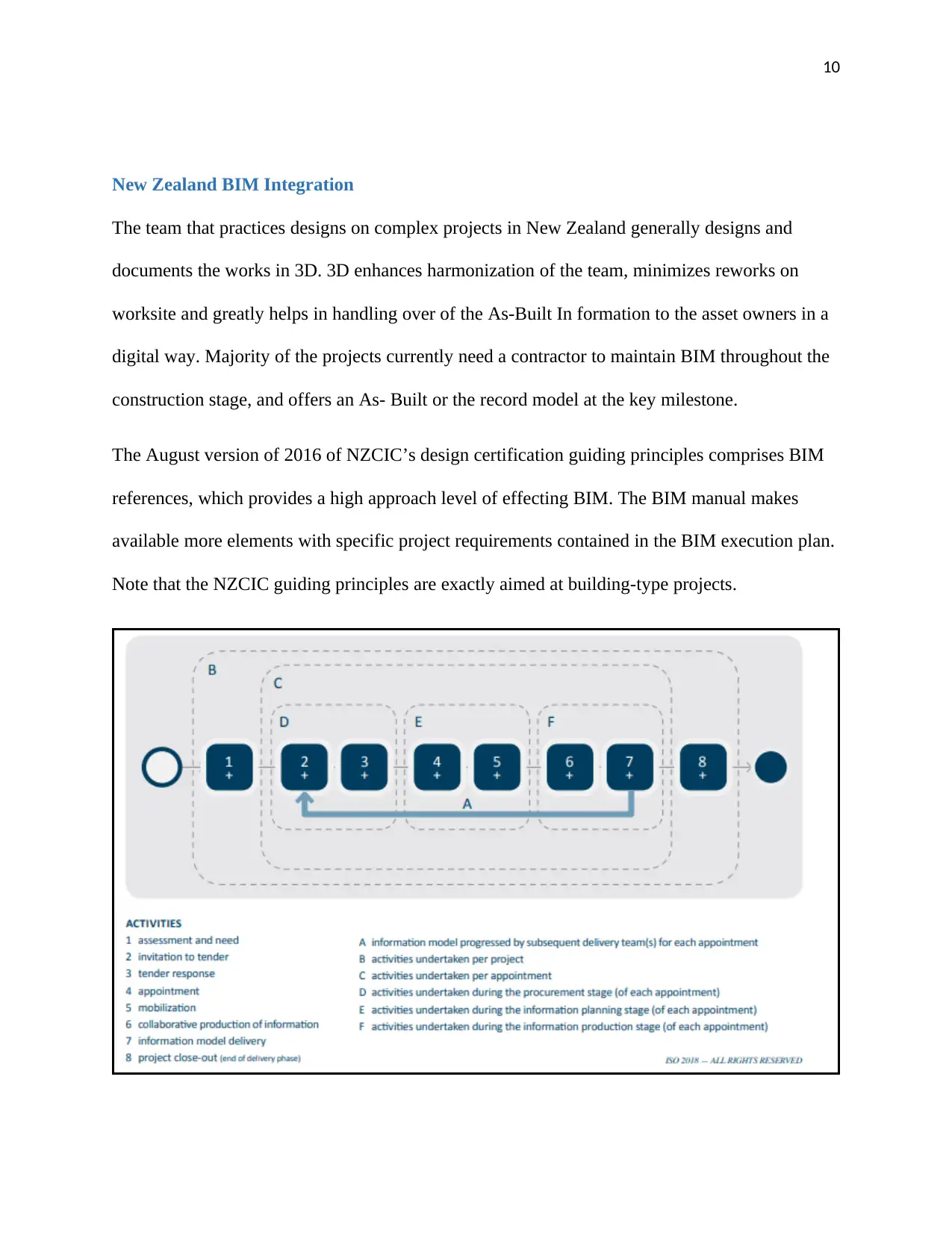
10
New Zealand BIM Integration
The team that practices designs on complex projects in New Zealand generally designs and
documents the works in 3D. 3D enhances harmonization of the team, minimizes reworks on
worksite and greatly helps in handling over of the As-Built In formation to the asset owners in a
digital way. Majority of the projects currently need a contractor to maintain BIM throughout the
construction stage, and offers an As- Built or the record model at the key milestone.
The August version of 2016 of NZCIC’s design certification guiding principles comprises BIM
references, which provides a high approach level of effecting BIM. The BIM manual makes
available more elements with specific project requirements contained in the BIM execution plan.
Note that the NZCIC guiding principles are exactly aimed at building-type projects.
New Zealand BIM Integration
The team that practices designs on complex projects in New Zealand generally designs and
documents the works in 3D. 3D enhances harmonization of the team, minimizes reworks on
worksite and greatly helps in handling over of the As-Built In formation to the asset owners in a
digital way. Majority of the projects currently need a contractor to maintain BIM throughout the
construction stage, and offers an As- Built or the record model at the key milestone.
The August version of 2016 of NZCIC’s design certification guiding principles comprises BIM
references, which provides a high approach level of effecting BIM. The BIM manual makes
available more elements with specific project requirements contained in the BIM execution plan.
Note that the NZCIC guiding principles are exactly aimed at building-type projects.
Paraphrase This Document
Need a fresh take? Get an instant paraphrase of this document with our AI Paraphraser
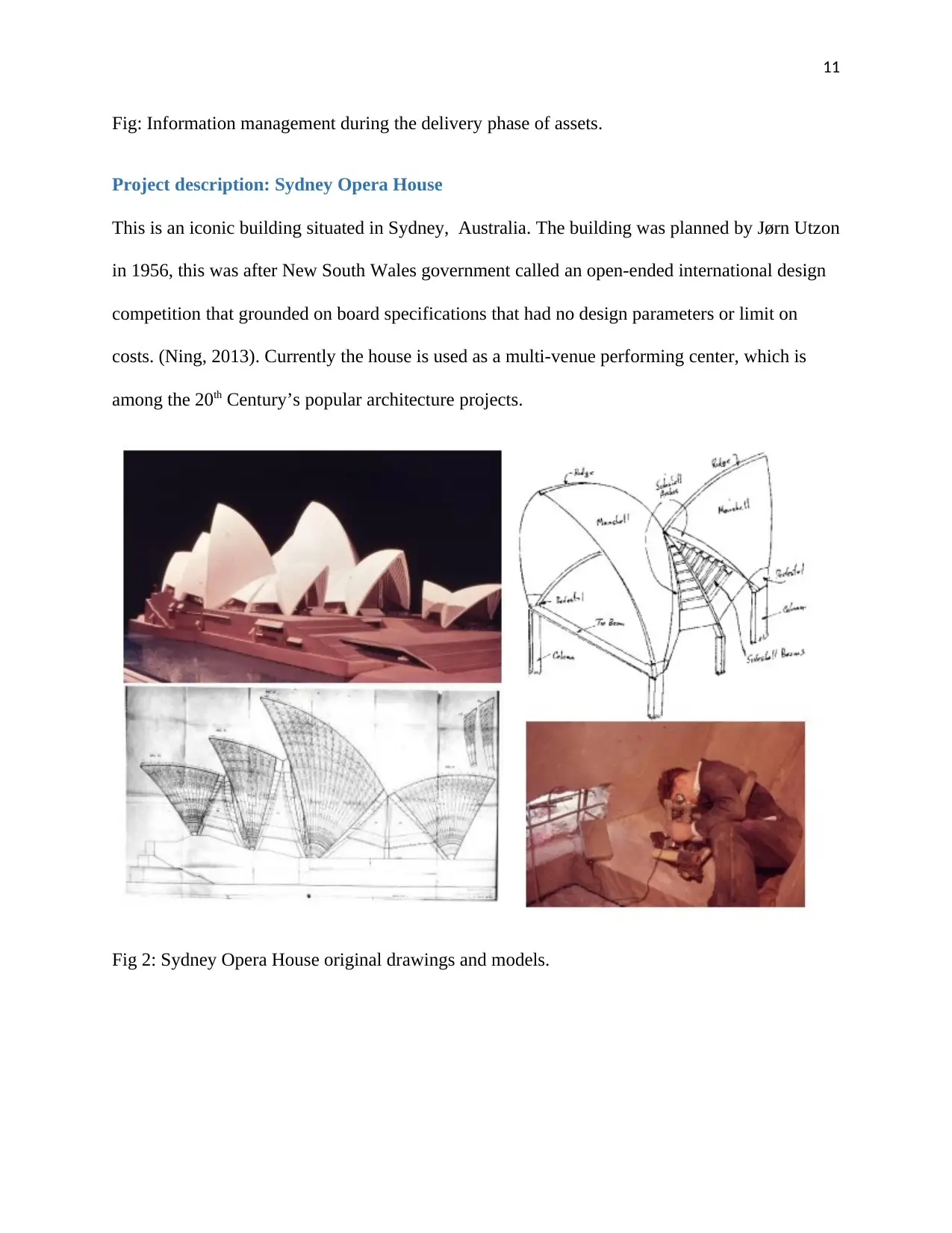
11
Fig: Information management during the delivery phase of assets.
Project description: Sydney Opera House
This is an iconic building situated in Sydney, Australia. The building was planned by Jørn Utzon
in 1956, this was after New South Wales government called an open-ended international design
competition that grounded on board specifications that had no design parameters or limit on
costs. (Ning, 2013). Currently the house is used as a multi-venue performing center, which is
among the 20th Century’s popular architecture projects.
Fig 2: Sydney Opera House original drawings and models.
Fig: Information management during the delivery phase of assets.
Project description: Sydney Opera House
This is an iconic building situated in Sydney, Australia. The building was planned by Jørn Utzon
in 1956, this was after New South Wales government called an open-ended international design
competition that grounded on board specifications that had no design parameters or limit on
costs. (Ning, 2013). Currently the house is used as a multi-venue performing center, which is
among the 20th Century’s popular architecture projects.
Fig 2: Sydney Opera House original drawings and models.
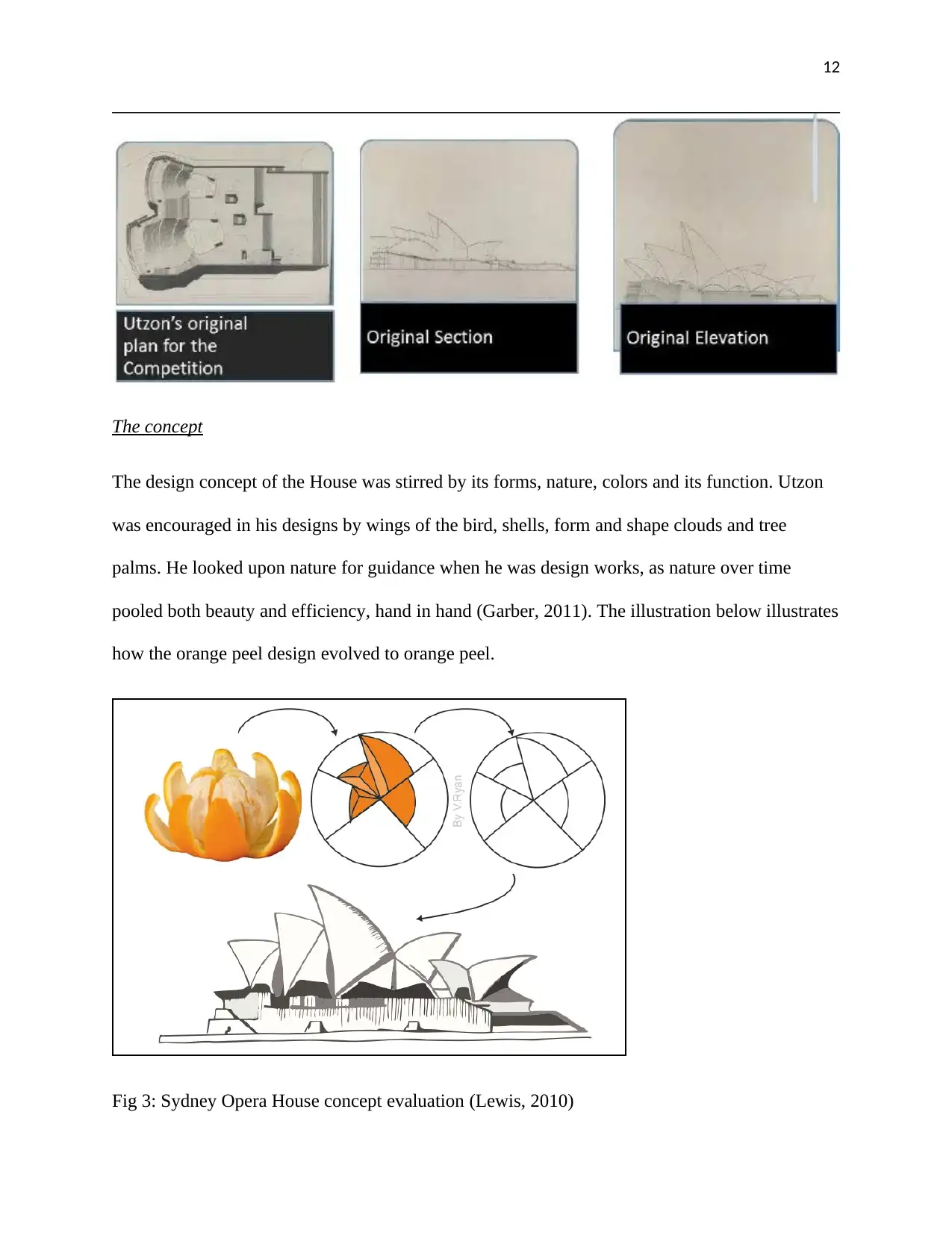
12
The concept
The design concept of the House was stirred by its forms, nature, colors and its function. Utzon
was encouraged in his designs by wings of the bird, shells, form and shape clouds and tree
palms. He looked upon nature for guidance when he was design works, as nature over time
pooled both beauty and efficiency, hand in hand (Garber, 2011). The illustration below illustrates
how the orange peel design evolved to orange peel.
Fig 3: Sydney Opera House concept evaluation (Lewis, 2010)
The concept
The design concept of the House was stirred by its forms, nature, colors and its function. Utzon
was encouraged in his designs by wings of the bird, shells, form and shape clouds and tree
palms. He looked upon nature for guidance when he was design works, as nature over time
pooled both beauty and efficiency, hand in hand (Garber, 2011). The illustration below illustrates
how the orange peel design evolved to orange peel.
Fig 3: Sydney Opera House concept evaluation (Lewis, 2010)
⊘ This is a preview!⊘
Do you want full access?
Subscribe today to unlock all pages.

Trusted by 1+ million students worldwide
1 out of 25
Related Documents
Your All-in-One AI-Powered Toolkit for Academic Success.
+13062052269
info@desklib.com
Available 24*7 on WhatsApp / Email
![[object Object]](/_next/static/media/star-bottom.7253800d.svg)
Unlock your academic potential
Copyright © 2020–2025 A2Z Services. All Rights Reserved. Developed and managed by ZUCOL.





